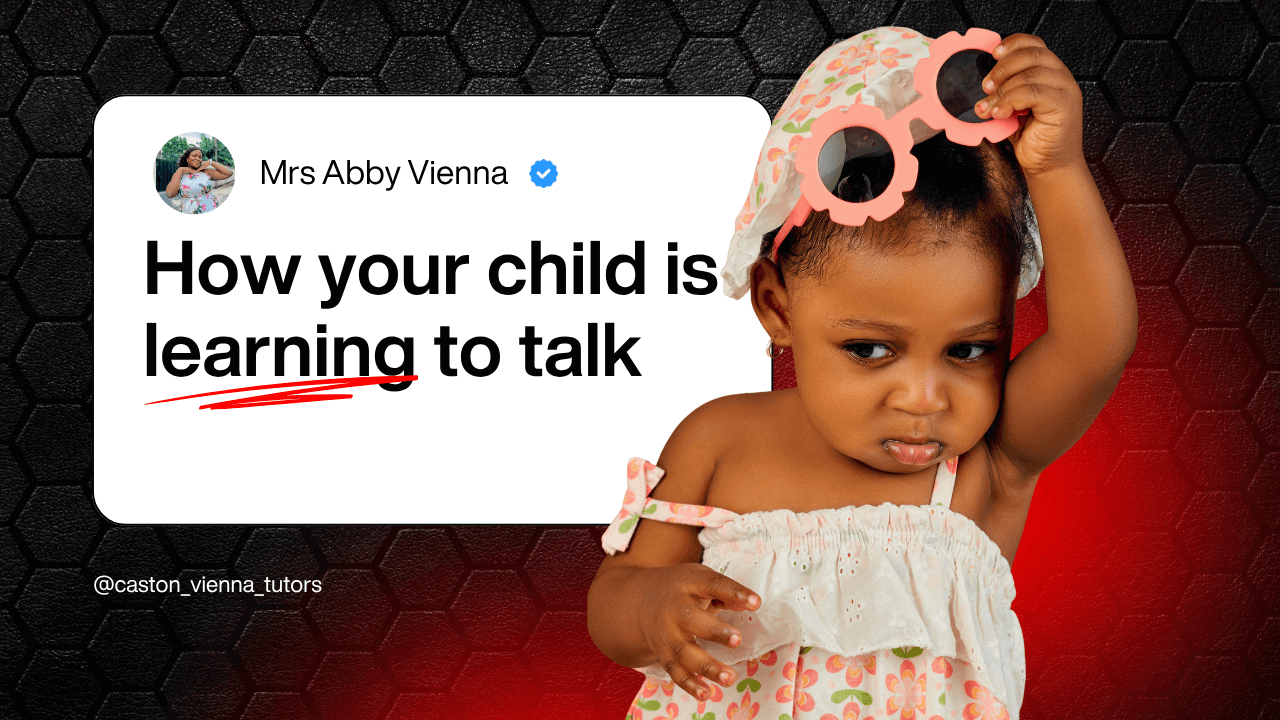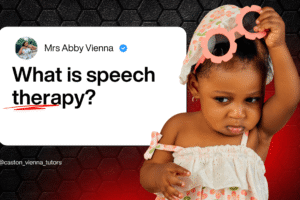
How your child is learning to talk and How you can help
As babies grow up and try learning to talk, they make different sounds. Now, there are sounds we use in speaking to one another called speech sounds. These sounds are complex for the cognitively immature child to produce. They may struggle with producing and perceiving certain sounds. So, children pronounce words the best way they can. That is why children pronounce words like “rain” as “wain” or “plane” as “pane.”
While this may be cute, it is a normal aspect of language learning you should take note of. Children do this because they are learning to talk. They are trying to align the movements of their tongue, lips, jaw, teeth, and palate to produce speech sounds. And they make errors during this process. The absolute worst thing you can do is either mimic them always without modelling the correct way they can follow, or never mimic them and leave them lost!
So, when your child is learning to talk in this phase, what do you do? How do you help them? Sit tight.
What Children Use When Learning to Talk
When a child is trying to talk and make speech sounds, the patterns of sounds they produce is called phonological processes. They are the different ways your child will change a difficult sound to an easier one so that they can at least communicate. These patterns are usually predictable speech errors all babies use as they learn to talk.
From your womb, your baby hears the speech sounds of the language you speak. Now, while they cannot produce the sound, they know what it should sound like in their head. And they can’t produce all the sounds because they cannot yet coordinate their tongue, lips, teeth, palate, and jaw for clear speech. Therefore, they have to use simple sounds until they can control their oral muscles.
That is why baby talking is almost always the same.
Let me explain it again. Your baby’s brain and muscles are not yet powerful enough to speak well like you. But we must communicate, right? So, the baby’s brain wants it to survive and so, it will create new rules. More like saying to the baby, “manage this sounds for now.” The rules or patterns are what we professionals call phonological processes.
For example, baby’s cannot instantly start producing sounds at the back of their mouth. Sounds that come the back of the mouth are /k/ and /g/. So, the brain makes the child ‘manage’ easier sounds, and so, the child will change it for sounds made at the front of the mouth (where it’s easier). As a result, /k/ becomes /t/, and /g/ becomes /d/. This explains why it’s typical for young children to say “titty tat” instead of “kitty cat.” That is a phonological process. You feel me?
It’s important to note that the baby cannot control these rules themselves. They do not choose to omit consonants at the end of words or alter sounds. Their brain does it automatically, and they may not even be aware that they’re doing it.
Types of Phonological Processes in Learning to Talk
The reason for this article is to teach you what to expect and what to do to assist your baby in learning to talk. At certain ages, we expect that children will use phonological processes. It will only become a problem when the child does not try to stop using these processes when they have grown above the age. While most children naturally outgrow this stage, many children may require speech therapy to overcome it.
Again, all children use some types of phonological processes. But if you work with the baby, you will assist them in learning to talk and they will drop the phonological process faster.
Now, let us look at the types so that you can understand how they work, and what you can do to help your child outgrow it when the time comes. Here are some types of typical phonological processes:
1. Assimilation
Assimilation is a phonological process in which a baby uses an easy sound found in a word to call another sound they may struggle with in that same word. For example, if a child says “gog” instead of “dog”, this is an example of assimilation. This is because the /g/ sound is in the same word, and as the child struggles with the the /d/ sound in the word, the brain ‘manages’ the easier one. Another example is when a child says “baba” instead of “bottle”. In this case, the baby replaced the /t/ sound by the /b/ sound from the previous syllable. We call that regressive assimilation. In that it went back.
Assimilation is common. As the child thought the word in their head, the easiest sound inside that word takes over and boom! Here are some different examples of assimilation in children:
a) Nasal Assimilation: Nasal sounds are sounds we produce with the nose, like sounds /n/ and /m/. Now, nasal assimilation is when a sound that is not a nasal consonant becomes nasal because a nasal consonant is easier to say. For example, the word “lamb” may be pronounced as “nam” because of the influence of the nasal “m” sound.
b) Labial Assimilation: Labial sounds are sounds produced primarily using the lips, such as /p/,/b/,/m/,/w/,/f/, and /v/. Most of them are easy to say. Now, a baby can change a non-labial consonant into a labial consonant because there is a labial consonant in the word. For example, the word “cup” may be pronounced as “pup” because of the influence of the labial “p” sound.
c) Velar Assimilation: Velar sounds are those produced at the back of the mouth using the back of the tongue (the velum), which include the consonants /k/,/g/, and /ŋ/ (the ‘ng’ sound). This assimilation is when a non-velar consonant becomes a velar consonant due to the influence of a neighboring velar consonant. For example, the word “dog” may be pronounced as “gog” because of the influence of the velar “g” sound.
d) Voicing Assimilation: This occurs when a voiceless consonant becomes voiced due to the influence of a neighboring voiced consonant. For example, the word “cat” may be pronounced as “gat” because of the influence of the voiced “g” sound.
e) Devoicing Assimilation: This occurs when a voiced consonant becomes voiceless due to the influence of a neighboring voiceless consonant. For example, the word “bed” may be pronounced as “pet” because of the influence of the voiceless “p” sound.
2. Dissimilation
Dissimilation is a phonological process in which a child changes a sound in a word to make it less similar to another sound in the same word. The goal of this change is to make the sound come out clearer. Or to avoid a difficult sequence of two very similar or identical sounds.
It is the opposite of assimilation, where a sound changes to become more like a neighboring sound.
For example, a child might pronounce the word “yellow” as “yeyow” to avoid the difficult sequence of two “l” sounds. Similarly, the child might pronounce the word “spaghetti” as “pasketti” to avoid the struggle to place the “s” in front of “p”.
Dissimilation is common in young children’s speech development. It typically disappears as their speech becomes more mature. You can help children overcome dissimilation by modeling correct pronunciation and providing gentle correction when needed. More on that later. Now…
Types of Dissimilation
There are several types of dissimilation that can occur in children’s speech. Here are some examples:
a) Regressive dissimilation: In this type of dissimilation, a sound that comes later in the word influences the sound that comes before it. For example, a child might pronounce the word “apple” as “appe” because the “l” sound is influenced by the “p” sound that comes after it.
b) Progressive dissimilation: In this type of dissimilation, a sound that comes earlier in the word influences the sound that comes after it. For example, a child might pronounce the word “banana” as “banao” because the second “n” sound is influenced by the first “n” sound.
c) Total dissimilation: In this type of dissimilation, a sound is completely changed or eliminated from the word. For example, a child might pronounce the word “spoon” as “poon” because the “s” sound is eliminated.
d) Partial dissimilation: In this type of dissimilation, a sound is changed only slightly from its original pronunciation. For example, a child might pronounce the word “water” as “wawa” because the “t” sound is changed to a “w” sound.
These types of dissimilation can occur in combination with other phonological processes, such as deletion, substitution, and addition, as children develop their speech skills.
3. Deletion
Deletion is a common phonological process in which a child omits or leaves out a sound or syllable in a word. This process is a natural part of children’s speech development as they learn to produce more complex sounds and syllables.
There are several types of deletion that can occur in children’s speech:
a) Final consonant deletion: This is when a baby removes the last consonant in a word. For example, the word “cat” may be pronounced as “ca.”
b) Cluster reduction: Because consonant clusters are difficult for babies, they may omit one or more consonants in the consonant cluster. A consonant cluster is when a word has two or more consonants in a syllable. Normal words have one consonant per syllable. For example, the word “stop” has to consonants at the begining. A baby may say it as “top.” Cluster reduction is a phonological process in which a child simplifies a group of consonant sounds by turning them into a single sound or a more manageable combination of sounds, as seen in examples like “poon” for “spoon” and “tuck” for “truck.”
c) Syllable deletion: This happens when your child deletes an entire syllable in a word. Weak Syllable Deletion is a phonological process in which a child deletes an unstressed syllable in a word, such as saying “nana” for “banana” or “puter” for “computer.” Or like my baby, who said “tah” instead of “water”.
It’s important to note that while deletion is a normal part of children’s speech development, it should decrease as a child’s speech becomes more mature. If a child is still exhibiting significant deletion patterns past a certain age (typically around 3-5 years old), it may be a sign of a speech or language disorder. Please see a speech therapist.
4. Epenthesis
Epenthesis (from Greek, meaning “putting in”) is a phonological process where a sound or syllable is inserted into a word. Children use this strategy to simplify the pronunciation of words, often to break up consonant clusters or to follow a preferred syllable structure.
For example, a child might say “buh-lue” instead of “blue” or “su-pas-ghetti” instead of “spaghetti.” The child is inserting an extra sound in the middle of the word to make it easier to pronounce.
The main function of epenthesis in child speech is to make words conform to simpler syllable patterns, such as the preferred Consonant-Vowel (CV) structure.
It typically manifests in two primary ways:
a) Vowel Epenthesis (Anaptyxis): This involves adding a vowel, most often an unstressed vowel like the schwa sound /ə/ (“uh”), to split up a group of consonants (a consonant cluster) that the child finds difficult to say together. For example, “spoon” can become “suh-poon” /səpun/: A vowel is added to break the initial /sp/ cluster.
Epenthesis is a normal part of language development, and most children grow out of it by the age of four or five. However, if a child continues to use epenthesis beyond this age or if it is accompanied by other speech difficulties, it may be a sign of a speech or language disorder and may require professional intervention.
5. Metathesis
Metathesis is a phonological process where a child swaps the position of two sounds in a word. For example, a child might say “aminal” instead of “animal.” The child is switching the positions of the “n” and “m” sounds in the word.
Metathesis is a normal part of language development, and most children grow out of it by the age of four or five. However, if a child continues to use metathesis beyond this age or if it is accompanied by other speech difficulties, please see a speech therapist.
These are the most common ways your child is learning to talk. They will most likely outgrow it. What happens when they don’t?
What is a Phonological Disorder when learning to talk?
If your child continues to use sounds as though they are still learning to talk beyond the expected age range, or if they talk in an unclear manner, it could be a sign of a phonological disorder.
I know. It can frustrate a child when they’re still learning to talk while their peers are already arguing their way into treats. That is why children with phonological disorders may exhibit tantrums, such as crying, screaming, sighing loudly, stomping, or throwing objects. They may display “aggressive” behaviors, such as biting, hitting, pulling, and shoving. This is often due to feeling misunderstood. And since they cannot effectively communicate their wants and needs, they grow angrier. These behaviors affect the child and you too.
What can you do?
My dear, call a speech therapist near you. Your child will talk clearly, but they may need extra assistance to speed things up. Consistent speech therapy can be highly effective in targeting phonological processes, leading to faster improvements in speech intelligibility.
Help Your Child in Learning to Talk
I did promise to give you tips.
When your baby starts learning to talk, you must remember that you are both playmate, entertainment and life role model. Your baby wants to be like you and sound like you. That said, you must talk with your baby. And when talking with your baby, use less baby talk. Let baby talk be for play time only. And play time should not be every time, as that will not be good for the baby’s development. Read, sing, and have conversations with your baby as they’re learning to talk.
If you fear that your child has not mastered phonological processes and is still using them, or that there may be some phonological disorders, please get help. For example, we are speech therapists in Port Harcourt. We also have homeschooling programs that focus on childhood development of essential skills through one on one private home learning, in home therapy, and so on.
Consult with a speech-language pathologist (SLP). An SLP can assess the child’s speech and provide a diagnosis of the phonological disorder. They can also develop a personalized treatment plan to target specific areas of difficulty.
You can also sign your child up for consistent speech therapy with an SLP. Regular speech therapy sessions can help children improve their speech sounds and intelligibility. The SLP will work with the child to practice correct sound production and may use activities and games to make the therapy sessions engaging and fun.
As the child progresses, encouraging and praising their efforts can boost their confidence and motivation to continue working on their speech. Parents and caregivers can provide positive feedback for correct sounds and offer gentle correction for incorrect sounds.
It is always joyful to watch children develop through developmental milestones and achieve new skills. While phonological processes are cute when your child is very young, take action when they are not outgrowing them.

